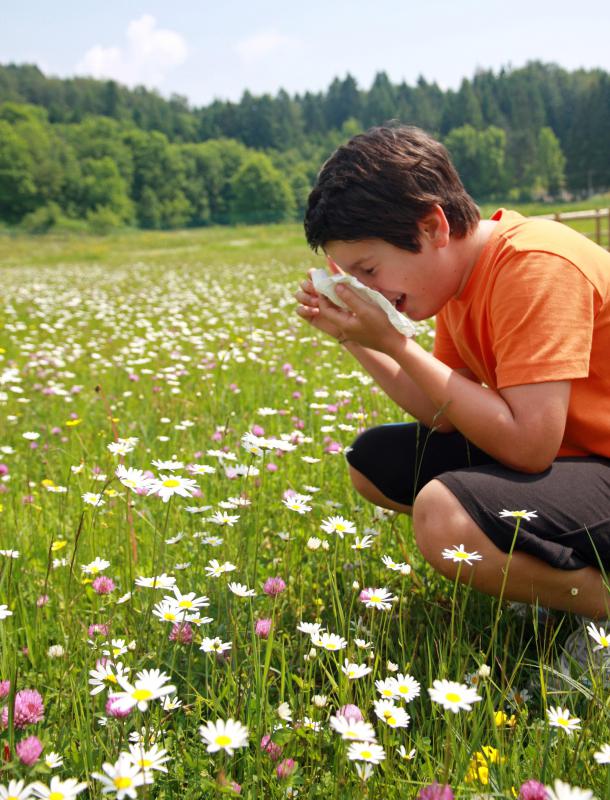At WiseGEEK, we're committed to delivering accurate, trustworthy information. Our expert-authored content is rigorously fact-checked and sourced from credible authorities. Discover how we uphold the highest standards in providing you with reliable knowledge.
What are the Medical Uses of Scutellaria Baicalensis?
Scutellaria baicalensis, also known as Baikal skullcap or huang qin, is frequently used in homeopathic medicine. Because it has properties that work as an anti-inflammatory, antioxidant, and anti-allergen, it is often used to treat fevers, coughs, diarrhea, urinary conditions, allergic rhinitis, and wheezing. In addition, some people believe the herb is helpful to treat secondary ailments caused by diabetes and cancer.
Native to China, Russia, Mongolia, Korea, and Japan, scutellaria baicalensis has been used in Chinese medicine for thousands of years. In fact, in the 1970s, 92 wooden tablets were found in northwestern China that dated back to the Second century, indicating that the ancient Chinese people used the herb for a wide variety of ailments. It grows well in open areas and on sunny slopes. It often grows anywhere from 1 foot (.3 m) to 4 feet (1.2 m) in height and has spear-shaped leaves with bluish-purple flowers.

The root is the only part of scutellaria baicalensis that is used, and it is typically harvested when the plant is three or four years of age. It is often made into a decoction to treat feverish chest colds. In those cases, the decoction or boiled root is typically consumed, like a tea, three times each day. In other cases, a tincture is made by soaking the root in alcohol. Then, 40 drops or so of the tincture is added to water and consumed three times a day to treat allergic reactions, such as hay fever.

Research has shown that the flavonoids in scutellaria baicalensis are helpful in treating allergies and respiratory conditions, such as asthma, nettle rash, eczema, and hay fever. The flavonoids work by preventing inflammation in body from allergic reactions. In addition, some basic findings have shown that it may treat bronchitis, allergic rhinitis, high blood pressure, dysentery, and even hepatitis. Some laboratory studies suggest that it may have anticancer properties as well. More research needs to be conducted before it can be recommended to treat those conditions, however.

As with any drug or herb, a doctor should be consulted before using scutellaria baicalensis. In addition, it should only be purchased from a reputable homeopathic pharmacy. Some remedies have been contaminated with a plant that looks very similar to Baikal skullcap, but the side effects can be quite severe and may even cause liver damage or hepatitis. Side effects that were reported from Baikal skullcap include seizures, confusion, and stupor. Also, it should not be used in conjunction with anticoagulant drugs.
AS FEATURED ON:
AS FEATURED ON:


















Discussion Comments
@andromeda- Yes, the two plants are similar. They come from the same family, basically. Studies have shown that there isn’t really any significant difference in the antioxidant potential of either plant. Both have been compared in the use of treating neurological disorders as well.
Baicalin, baicalein, and wogonin are found in both. Serotonin and melatonin have also been found in the stem and leaf tissue of both of these plants.
That is as far as my knowledge goes on the likeness between the two. They may very well have more in common.
Is Scutellaria baicalensis similar to scutellaria lateriflora? I have heard of scutellaria lateriflora.
Using herbs for medicinal purposes seems to be gaining popularity again. I like to stay up to date on herbs and the possibilities they present for adding to health conscious lifestyle.
I was first introduced to Scutellaria baicalensis for its anti-inflammatory properties. I have had pre-hypertension. This herb taken as a supplement seems to be what has brought my blood pressure down.
I made sure to make healthy choices along with adding this supplement. Combined with less salt intake and more physical activity, the results have been positive. I haven’t had any negative side effects and will more than likely continue to use Scutellaria baicalensis.
I have been interested in Chinese skullcap for the possible anti-aging benefits. There has been research at a number of U.S, medical institutions. Chinese skullcap contains some impressive anti-aging molecules. There has been some excitement about the baicalin, baicalein, and wogonin found in Chinese skullcap.
I have not started using it, yet. I am going to talk to my doctor and see if I can add this to my daily regimen. Wouldn’t it be great to have a healthy, alternative ant-aging product? I don’t want to have needles stuck in my skin with poisonous substances. A lot of us want to keep our youth, but not damage our bodies.
Post your comments